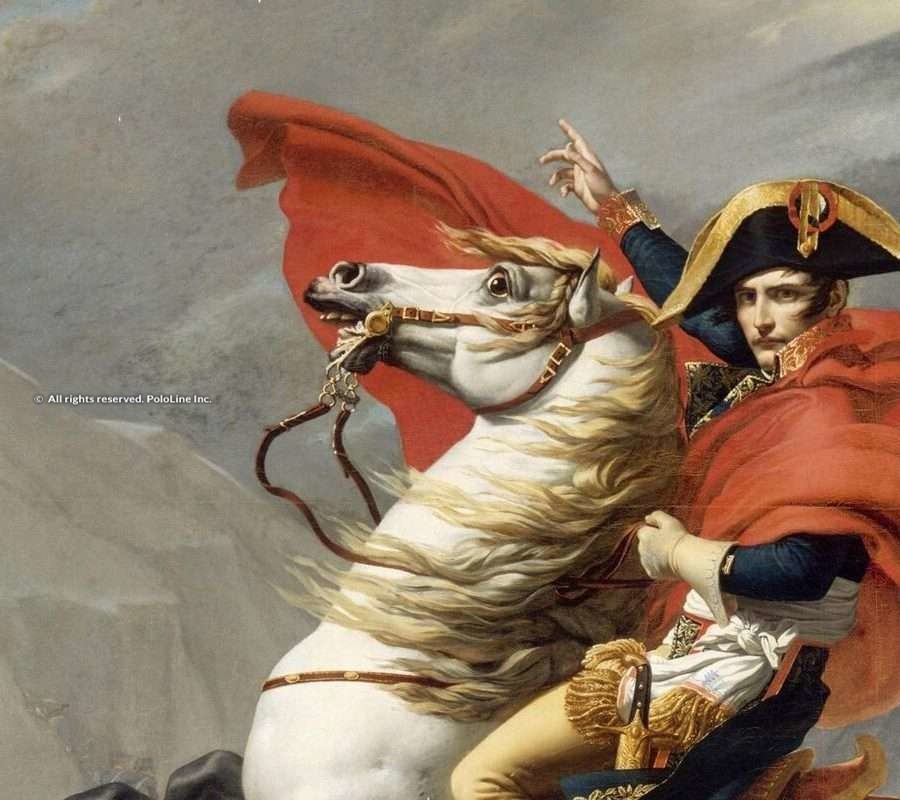By Alejandra Ocampo
“Napoleon”, the movie based on Napoleon Bonaparte’s rise to power, directed by Ridley Scott and starring Joaquin Phoenix as one of the most remarkable personalities in history, was released last November. As loved as controversial, Napoleon is renowned as one of the most brilliant, greatest military commanders ever, who also left a remarkable political legacy behind. Born in Ajaccio, Corsica, in 1769, Napoleon led the French Army to several successful military campaigns, during the era known as the Napoleonic Wars, in the late XVIII Century and early XIX Century. His victories consolidated and expanded his power until he crowned himself Emperor of France in 1804. But he was not alone to fullfil his destiny – carrying him in battle was his most faithful ally, his favourite horse, Marengo.
According to some historians, Napoleon was not a good rider, but owned around 130 horses in his stud. He used to name them after mythological figures and historical personalities (Cyrus, Tauros, Nero) as well as geographical places where he achieved significant military victories. Cyrus was one of them – he was re-named Austerlitz, after the decisive battle, often cited as one of Napoleon’s most remarkable military tactical masterpieces, that ended up with the retreat of the Austrian and Russian Empires, in 1805.
Marengo’s close bond with Napoleon began around 1798, during the campaign to Egypt and following the Battle of the Pyramides. Napoleon was impressed by the Egyptian soldiers’ extraordinary cavalry and their outstanding riding skills. But what he liked the most was the beauty, speed and strength of the Arabian horses, who have been carefully bred in the land of the Pharaos for centuries.
To Napoleon, Arabian horses were the best. That’s why he decided to choose many of those magnificient horses in order to import them to France. But there was one horse that caught Napoleon’s eye; an extremely beautiful Arabian greyish-white coat who, in his opinion, represented the Arabian horse at its best. The then seven-years-old majestic horse was brought to France around 1800. Four years later, in 1804, the horse that dazzled Napoleon, carried him to Italy, to take part of the Battle of Marengo, where the French defeated the Austrian troops brilliantly. Indeed, the Battle of Marengo was crucial for Napoleon, leading him to glory on his path to become Emperor of France and King or Italy. As a consequence of such a remarkable military achievement, Napoleon bestowed the name Marengo, upon the splendid mount and became his favourite.
Marengo, the Arabian breed, greyish white-coat, was a reliable and steady horse, although small in size, only 145 cm. Napoleon’s horses were tamed through a very sophisticated technique in order to prepare them to serve on the gruesome battlefields. His horses used to be docile, and most of all, small, due to the Emperor’s shortness (his height was around 168 cm). Napoleon saw his own qualities on his favourite horse: courage, strength, determination and an extraordinary endurance, which made the fabulous stallion a fantastic battle horse. In addition, that endurance allowed Marengo to be a remarkable horse to gallop, as well – he completed gallops that usually took five hours in three hours.
Marengo carried his restless owner on several of his military campaings; the duo achieved significant victories, such as Austerlitz (1805) and Wagram (1809), among others. Marengo was wounded eight times in his career, but he bounced back quickly, ready to go back to the battlefield.
In 1812, Marengo were among the 52 horses Napoleon brought to a campaign in Russia, which proved to be a complete disaster. Due to the frozen cold weather conditions, Napoleon lost 80% of his army and 12.000 horses on his way to Moscow. But Marengo was one of the few horses who survived the retreat and the frozen cold. Marengo managed to carry Napoleon from Moscow to Paris in the worst conditions. It is said that this terrible defeat was the premonition of a worse catastophe.
In 1814, Napoleon was forced to abdicate as Emperor of the French, and sent to exile to the island of Elba. He remained there until March 1815, when he escaped to Paris, where he was enthusiastically greeted. He set an army to face his enemies, who were determined to overthrown him; the most famous was the Seventh Coalition under the command of the British Field Marshal Arthur Wellesley, First Duke of Wellington, that finally were victorious over Napoleon and the French Army in the Battle of Waterloo, on June 18 1815. As usual, Marengo was carrying his owner; badly wounded and walking around the devastated battlefield, the stallion was found and captured by William Petre, 11th. Baron of Petre.
Following the catastrophic defeat at Waterloo, Napoleon was sent to exile to the island of Santa Helena, where he would die in 1821. Meanwhile, Baron Petre brought the horse back to England; Marengo remained in England until he passed away in 1831, aged 38. Today, Marengo’s skeleton is on display at the National Army Museum, in Sandhurst. A couple of the remaining hooves were converted into a silver snuff boxes.
A crucial and almost unexpected victory in Italy, in 1804, opened the path to Napoleon to a formidable career that led him to glory and provided him an extraordinary bond with a horse he loved deeply, named after that remarkable military achievement, Marengo; the Arabian breed, greyish white-coat that dazzled Napoleon in Egypt, who was his most faithful companion, carrying him through thick and thin.
Cover photo: Napoleon and Marengo crossing the Alps, painting by Jacques-Louis David (1801).

